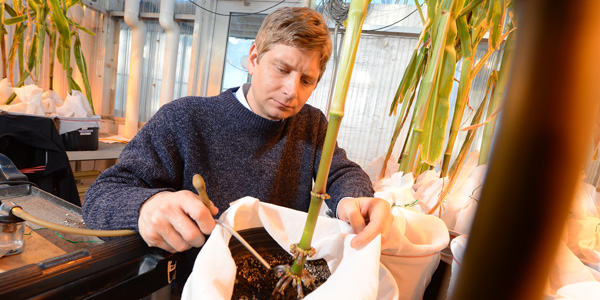
Evolving Strategies versus Bt Resistance, Rootworms
Rootworms are developing a natural resistance to Bt corn, which is genetically engineered to produce insecticidal proteins derived from the bacterium Bacillus thuringiensis.
In many ways, the Bt resistance issue represents an intersection of Gassmann’s professional interests: agriculture, ecology and evolution.
“The study of insects in agriculture is a natural way to address these different topics, because the development of pest resistance is so important to agriculture and such a natural application of evolutionary theory,” he says.
Born and raised in Dubuque, Gassmann traveled to universities from coast to coast earning degrees and research experience in biology, chemistry, mathematics, ecology and evolution. He earned his doctorate from the State University of New York and joined the faculty at Iowa State in 2008. His appointment is mostly devoted to research, but he also teaches classes in integrated pest management, plant-insect interactions and population genetics.
The cases he uncovered of rootworm resistance to Bt are unfortunate, he says, but not surprising given the insect’s adaptability.
“The western corn rootworm has a very limited rate of dispersal, which has been conducive to the development of resistance. Farmers were in essence conducting selection experiments over the 13 million acres of corn in Iowa,” he says.
The first cases of resistance were found in Northeast Iowa, from fields of continuous corn where the same Bt corn hybrid had been used for at least three years. Laboratory studies had predicted resistance when three or more generations of insects were exposed to Bt corn.
Gassmann says Bt corn is a very valuable technology mainly because it reduces the use of some conventional insecticides.
“Basically, Bt corn reduces the environmental footprint of agriculture. But one of the concerns of planting Bt crops is maintaining its effectiveness,” he says.
The challenge now for Iowa
growers is that there is a “mosaic” of rootworm populations a
cross the landscape, some of which are resistant to Bt while others are susceptible.
“This complicates management for growers,” he says. “So a lot of my work is understanding the scope of the problem, the risk that is associated with additional cases of resistance and then how farmers can go about managing the pest in this more complex landscape.”
“The Iowa corn farmer welcomes a better understanding of how rootworms evolve under Bt pressure for long-term sustainability and to maximize the valuable technology currently available,” says Rodney Williamson, Iowa Corn director of research and business development. “The research Dr. Gassmann is conducting is an important tool in the farmer’s toolbox when developing the most effective management systems for rootworm control.”
Gassmann’s lab also is looking at the community of insect pathogens in the soil—naturally occurring ones that kill the western corn rootworm—to determine how common and important they are, but also how they might be used in conjunction with other pest management practices, such as Bt corn.



